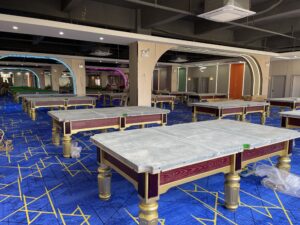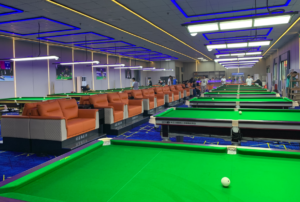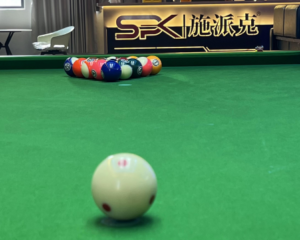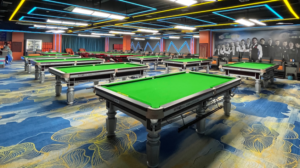A billiard table may seem like a simple piece of furniture made of slate, wood, and cloth, but it is actually a sophisticated system that embodies the wisdom of materials science and mechanics. From a flatness error of 0.1mm to a rebound angle control of 0.5 degrees, every structural detail directly affects the stability of the playing feel. Today, we will break down the core structure of professional billiard tables and how source factories achieve “tournament-level standards” through technological innovation.

1. Table Slate: The “Reference Surface” of the Table, Flatness Determines Everything
The table surface is the “stage” for billiards, and its flatness error must be controlled within a range invisible to the naked eye. Professional tables all use natural bluestone slabs rather than ordinary marble or artificial stone—bluestone has a density of 2.7g/cm³ and a Mohs hardness of 3.5, which can withstand the high-frequency vibrations from cue impacts without easily scratching.
Single Slab vs. Spliced Slabs: Chinese eight-ball tables mostly use 3 spliced slabs (total weight about 400kg), while snooker tables require 6 spliced slabs. The gap at the joints must be ≤0.1mm; otherwise, the cue ball will bounce when crossing the seam. After splicing, SPKI’s slabs are calibrated with a laser level, and the overall flatness error can be controlled within 0.3mm, far exceeding the World Professional Billiards and Snooker Association’s standard of 0.5mm.
Polishing Precision: Each slab undergoes multiple polishing processes, from rough grinding (removing surface impurities) to fine grinding (polishing with 800-grit sandpaper), ensuring uniform friction when the cue ball rolls.

2. Cushions and Rubber: The “Regulator” of Rebounds, Elasticity Tested Thousands of Times
Cushions are the “rebound boundaries” of the table, and the elasticity coefficient of their rubber directly determines the rebound angle of the balls. The cushions of professional tables are not simply rubber wrapped in wood, but a composite structure optimized through mechanics.
Rubber Material: High-elastic natural rubber imported from the UK must be used. SPKI’s cushion rubber undergoes 5,000 consecutive rebound tests, with an elasticity decay rate ≤3%, ensuring stable performance even after 3 years of use.

3. Table Cloth and Installation: The “Controller” of Ball Speed, Knowledge in the Pile
Table cloth is a key variable affecting ball speed. Differences in material, weaving density, and installation techniques can lead to variations in ball speed.
Material Selection: Tournament-grade cloth is 100% wool; the ball speed is faster in the direction of the pile and slightly slower against it, testing the player’s delicate control. Commercial billiard halls mostly use wool-polyester blended cloth, which is 50% more wear-resistant while retaining 80% of the tournament-level feel. SPKI customizes cloth for different scenarios: short-pile blended cloth is optional for home use, while tournament models use cloth imported from the UK.
Installation Technique: SPKI’s cloth installation is handled by craftsmen with over 10 years of experience, who calibrate each point with a dedicated tension meter to ensure the cloth fits perfectly with the slate without any bubbles or wrinkles.

4. Technical Strength of the Source Factory
The structural precision of professional billiard tables is inseparable from the source factory’s ultimate control over the production process. As an established factory with 23 years of experience, SPKI has cooperated with tens of thousands of offline billiard halls, and we are committed to crafting every table with care. At the same time, we support table customization, enabling SPKI’s tables to meet the durability needs of commercial halls, reach tournament-level precision standards, and even provide personalized styles tailored to home scenarios.
